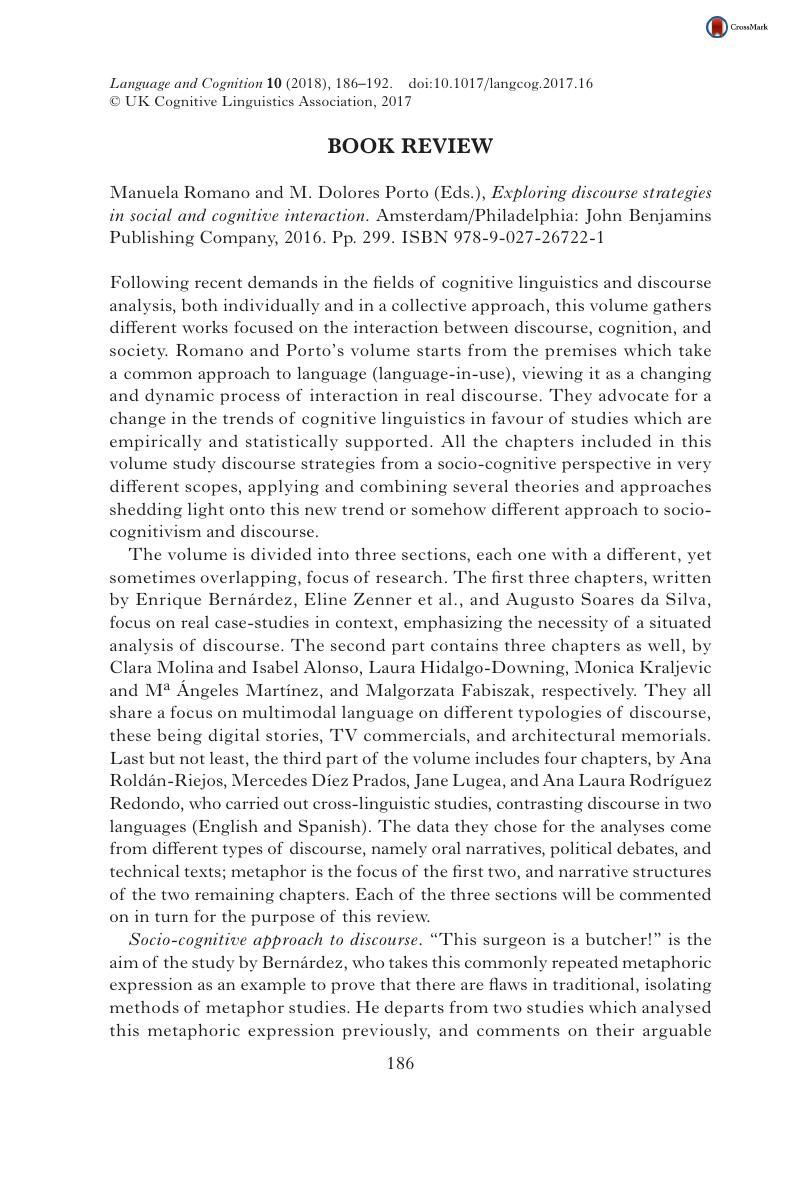No CrossRef data available.
Article contents
Manuela Romano and M. Dolores Porto (Eds.), Exploring discourse strategies in social and cognitive interaction. Amsterdam/Philadelphia: John Benjamins Publishing Company, 2016. Pp. 299. ISBN 978-9-027-26722-1
Published online by Cambridge University Press: 11 October 2017
Abstract
An abstract is not available for this content so a preview has been provided. Please use the Get access link above for information on how to access this content.

- Type
- Book Review
- Information
- Copyright
- Copyright © UK Cognitive Linguistics Association 2017
References
references
Bamberg, Michael (1985). Form and function in the construction of narratives: developmental perspectives. Unpublished PhD thesis, University of California, Berkeley.Google Scholar
Brandt, Line, & Brandt, Per Aage (2005). Making sense of a blend: a cognitive-semiotic approach to metaphor. Annual Review of Cognitive Linguistics, 11(1), 1–35.Google Scholar
Fauconnier, Giles, & Turner, Mark (2002). The way we think: conceptual blending and the mind’s hidden complexities. New York: Basic Books.Google Scholar
Gavins, Joanna (2007). Text world theory: an introduction. Edinburgh: Edinburgh University Press.Google Scholar
Grady, Joseph E., Oakley, Todd, & Coulson, Seana (1999). Blending and metaphor. In Steen, G. & Gibbs, R. (Eds.), Metaphor in cognitive linguistics (pp. 101–124). Amsterdam/Philadelphia: John Benjamins.CrossRefGoogle Scholar
Hunston, Susan (2000). Evaluation and the planes of discourse: status and value in persuasive texts. In Huston, Susan & Thompson, Geoff (Eds.), Evaluation in text: authorial stance and the construction of discourse (pp. 176–207). Oxford: Oxford University Press.CrossRefGoogle Scholar
Johnson, Mark (1987). The body in the mind: the bodily basis of meaning, imagination, and reason. Chicago: University of Chicago Press.Google Scholar
Lakoff, George, & Turner, Mark (1989). More than cool reason: a field guide to poetic metaphor. Chicago: University of Chicago Press.Google Scholar
Martin, James R., & White, Peter R. R. (2005). The language of evaluation: appraisal in English. Basingstoke: Palgrave Macmillan.Google Scholar
McNeill, David (1992). Hand and mind: what gestures reveal about thought. Chicago: University of Chicago Press.Google Scholar
Oakley, Todd, & Hougaard, Anders (Eds.) (2008). Mental spaces in discourse and interaction. Amsterdam: John Benjamins.Google Scholar
Pragglejaz Group (2007). MIP: a method for identifying metaphorically used words in discourse. Metaphor and Symbol, 22(1), 1–39.Google Scholar
Romano, Manuela, & Porto, M. Dolores (2010). Attentional markers in the structure of oral narratives of charged events. In Caballero, Rosario & Jesús Pinar, M. (Eds.), Ways and modes of human communication (pp. 729–736). Cuenca: Universidad de Castilla-La Mancha.Google Scholar
Romano, Manuela, Porto, M. Dolores, & Molina, Clara (2013). The structure of emotion discourse: from Labovian to Socio-Cognitive Models. Text and Talk, 33(1), 71–93.Google Scholar
Santos, Boaventura de Sousa (2010). Para além do pensamento abyssal: Das linhas globais a uma ecologia de saberes [Beyond abyssal thinking: from global lines to an ecology of forms of knowledge]. In Santos, Boaventura de Sousa & Meneses, Maria Paula (Eds.), Epistemologias do Sul (pp. 23–71). Coimbra: Almedina.Google Scholar
Stefanowitsch, Anatol (2006). Corpus-based approaches to metaphor and metonymy. In Stefanowitsch, Anatol & Gries, Stephan Th. (Eds.), Corpus-based approaches to metaphor and metonymy (pp. 1–16). Berlin/New York: Mouton de Gruyter.CrossRefGoogle Scholar
Sternberg, Robert J. (1999). Handbook of creativity. Cambridge: Cambridge University Press.Google Scholar
Werth, Paul (1999). Text worlds: representing conceptual space in discourse. London: Longman.Google Scholar
Zinken, Jorg, Hellsten, Ilina, & Nerlich, Brigitte (2008). Discourse metaphors. In Dirven, René, Frank, Roselyn, & Bernardez, Enrique (Eds.) Body, language, and mind: sociocultural situatedness, Vol. 2 (pp. 363–383). Berlin/New York: Mouton de Gruyter.Google Scholar





